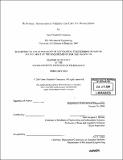Robotany : autonomous vehicles that care for houseplants
Author(s)
Cinnamon, Sara Elizabeth, 1979-
DownloadFull printable version (16.34Mb)
Alternative title
Autonomous vehicles that care for houseplants
Other Contributors
Massachusetts Institute of Technology. Dept. of Mechanical Engineering.
Advisor
Jean-Jacques E. Slotine.
Terms of use
Metadata
Show full item recordAbstract
Robotany is a system of autonomous robots that act on behalf of houseplants that rest on top of their chassis. Their duty is to do what plants would if they had the gift of mobility - namely to seek out sunlight or water when there are insufficient amounts of either at their current location. Despite the specialized application, the underlying framework of the robots is rather general and can be used in a variety of situations. The robots are designed to be easily modifiable for a given application. They are constructed using rapid-prototyping techniques that allow them to be built quickly and The software controlling Robotany utilizes a behavior-based approach, one that takes its cue from nature's solutions to problems facing any mobile being. It follows Braitenberg's model for seeking out light in an implicit manner. A new approach to obstacle avoidance is used, based on reactance to in situ sensor readings and a simplified internal map of the local environment. Robotany also incorporates a simple homeostatic system to regulate the quality of its behaviors and to determine when one behavior should take precedence over another. inexpensively. A novel design is utilized for the vehicle's suspension. This design is far simpler, cheaper, and more easily customized than traditional systems that perform the same task. The software controlling Robotany utilizes a behavior-based approach, one that takes its cue from nature's solutions to problems facing any mobile being. It follows Braitenberg's model for seeking out light in an implicit manner. A new approach to obstacle avoidance is used, based on reactance to in situ sensor readings and a simplified internal map of the local environment. Robotany also incorporates a simple homeostatic system to regulate the quality (cont.) of its behaviors and to determine when one behavior should take precedence over another. Experimental results presented in this thesis show that the robots are successful in finding sources of light while avoiding obstacles in their path.
Description
Thesis (S.M.)--Massachusetts Institute of Technology, Dept. of Mechanical Engineering, 2004. Includes bibliographical references (p. 91-95).
Date issued
2004Department
Massachusetts Institute of Technology. Department of Mechanical EngineeringPublisher
Massachusetts Institute of Technology
Keywords
Mechanical Engineering.